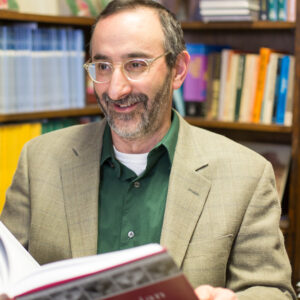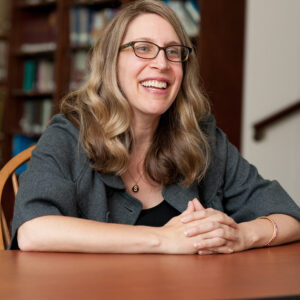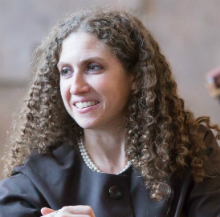
Where Is Authority Found?
May 6, 2016 By Benjamin D. Sommer | Commentary | Aharei Mot
People familiar with the dietary laws of Judaism know that meat from an animal that died a natural death or was torn apart by wild beasts is not kosher. This is stated explicitly in the Torah. Exodus 22:30 reads, “You shall be my holy people: you may not eat meat torn by beasts in the field; you should throw it to dogs.” (The Hebrew word for “torn by beasts”—terefah—refers specifically to torn flesh in biblical Hebrew.)
Read More
Songs of Joy, Counterpoints of Tragedy
May 6, 2016 By Jonathan Lipnick | Commentary | Aharei Mot
Perhaps the Torah speaks now, in the spring of atonement, because we know so well our songs of joy carry with them counterpoints of tragedy.
Why should we be reading about Yom Kippur around the time Pesah is celebrated? These two holidays seem so different, and yet, in her poem “Aharei Mot,” Ruth Brin was on to something, leading me to wonder: How was I to understand the interrelationship between Yom Kippur and Pesah? How was I to take Ruth Brin’s instructive words to heart?
Read More
Shevi’i Shel Pesah: Living at the Frontier
Apr 29, 2016 By Lauren Henderson | Commentary | Pesah
On the seventh day of Passover (Shevi’i shel Pesah), we reached the frontier of our existence: Yam Suf, the Sea of Reeds. We had known slavery intimately, becoming deeply comfortable in Egypt even as we clamored to leave. And after all the plagues and darkness and death, we arrived, trembling, at the water’s edge, about to surface and breathe the unfamiliar air of freedom for the first time.

Prophetess, Leader, Musician
Apr 29, 2016 By Matthew Berkowitz | Commentary | Pesah
Joy is the theme of the hour as God’s praises are sung during the completion of Hallel. The image that bursts forth in our mind’s eye is that of Miriam the Prophetess and the women celebrating their newly found freedom on the banks of the Reed Sea. While the moment is solemn, it is also one of intense elation.

Remembering Pesah 1946
Apr 22, 2016 By Avinoam Patt | Commentary | Pesah
Every Passover as we read the Haggadah, we recite:
In each and every generation, a person is obligated to regard himself as though he actually left Egypt. As it says: “You shall tell your son on that day, ‘It is because of this that God took me out of Egypt.’” (Exodus 13:8)
Seventy years ago, in April 1946, the first Passover in postwar Germany followed the liberation of the concentration camps. The survivors who gathered to form the She’erit Hapletah, the surviving remnant, felt this transition from slavery in a more immediate sense than any generation of the children of Israel in the 2,000 years that preceded them.
Read More
A Noble Freedom
Apr 22, 2016 By Tim Daniel Bernard | Commentary | Pesah
Many Virginians of middle and upper ranks aspired to behave like gentlemen. In the early seventeenth century an English gentleman was defined as one who could “live idly and without manual labor.” The words “gentleman” and “independent” were used synonymously, and “independence” in this context meant freedom from the necessity of labor.
Read More—David Hackett Fischer, Albion’s Seed: Four British Folkways in America, 366

Beyond the Exodus from Egypt
Apr 15, 2016 By Arnold M. Eisen | Commentary | Shabbat Hagadol | Pesah
Most of us, at one time or another, have asked the question about the Passover seder that the Haggadah attributes to the “wicked son”: What is the point of all this? At such moments of skepticism, we probably understand why an annual family gathering is worthwhile, we perhaps remember fondly the seders of our youth, and we may even confess to being moved by the rituals reenacted at the seder table year after year: reciting the four questions, dripping wine from cup to plate at the recital of the ten plagues, singing Had Gadya. But really, we ask: Why is the event of Israelite slaves leaving Egypt over 3,000 years ago (if it ever happened in the first place) so important that an entire holiday is devoted to it (not to mention countless daily prayers)?
Read More
Inside Out
Apr 15, 2016 By Ally Sterling | Commentary | Metzora
This week’s parashah, Metzora, details the special procedures a kohen performs to purify the recovered metzora (a person suffering from some kind of skin condition), tzara’at in the home, and ritual impurity. Metzora is about the insides (childbirth and emissions) and outsides (skin afflictions) of the body. I created Inside Out as part of a series of biological drawings that explores the beauty and intricateness of the inner workings of the human body. When I made Inside Out, I wanted to explore the different functions and shapes of human anatomy and physiology, and also the way in which everything is connected.
Read More



Keep Calm and Consult a Priest
Apr 8, 2016 By Hillel Gruenberg | Commentary | Tazria
Tazria begins with a discussion of the ritual purity of a woman following childbirth and goes on to relate the treatment of leprosy. Reflecting on this juxtaposition of topics, my thoughts turned to the Zika virus, which has garnered global attention because of evidence it may cause birth defects in the children of mothers infected while pregnant.
Read More
Here I Am, Tzara’at and All
Apr 8, 2016 By Rachel Rosenthal | Commentary | Tazria
When I was 12, a few weeks before my bat mitzvah I went in to meet with one of the rabbis of my synagogue. At the time, the synagogue newsletter included a “pasuk of the week,” a verse from that week’s Torah portion that was particularly interesting or thought provoking. However, as the rabbi confessed to me, the week of my bat mitzvah was to be the end of that custom. He just couldn’t find anything that fit the bill. That week’s parashah? Tazria.
Read More
Easing the Transition From Shabbat
Apr 1, 2016 By Shira D. Epstein | Commentary | Shemini
The parashah delineates several distinctions between holy and unholy: what constitutes an acceptable sacrifice; which animals fall within the category of kosher; the actions that might transition a vessel, oven, or garment to the status of unclean.
At the end of Shabbat, we invoke these same words during havdalah, praising God “who makes a distinction between holy and profane.”
Read More
How Can People Be Holy?
Apr 1, 2016 By Stephen A. Geller | Commentary | Shemini
Shemini (Lev. 9–11) contains two main topics: the elaborate sacrificial rites performed on the eighth day of the dedication of the Tabernacle, and the laws regarding kosher and nonkosher animals. The first topic details the numerous sacrifices accompanying the last stages of the dedication of the shrine, which reach an intensity matched only by the yearly rites of the Day of Atonement. This is no accident, because the annual event is meant to restore the shrine to the purity it possessed on the day it was dedicated.
Read More
Free Speech vs. Hate Speech: The Changing Contours of Free Expression
Mar 28, 2016 By The Jewish Theological Seminary | Public Event video
Frederick M. Lawrence—Yale Law School senior research scholar, past president of Brandeis University, and a leading expert on civil rights, free expression, and bias crimes—explores the boundaries of free expression in the 2016 Bernard G. Segal Memorial Lecture.
Read More
A Set Table
Mar 25, 2016 By Yonatan Dahlen | Commentary | Tzav
Read MoreI try to bless
When I wear Your stars as my blanket;
My winter coat when days are dark
When life is a knife
Resting on the altar of time.

Creating I-Thou Moments That Strengthen Relationships, and Communities
Mar 18, 2016 By Stephanie Ruskay | Commentary | Pekudei
Semikhah, ordaining of clergy, is on my mind these days as we move closer to my first JTS ordination as an associate dean. No longer the person receiving semikhah, this time I am privileged to help ordain new clergy.
Read More
Purim Heroines
Mar 18, 2016 By Stefanie B. Siegmund | Commentary | Purim
I did not wear the crown and satiny dress, or stand in line for the beauty pageant. Queen Esther was not a role model I—or many other children—could choose. Later, in the academy, I understood that Esther’s subterfuge and seduction were the strategies of the weak, the politics of the minority.
Read MoreSUBSCRIBE TO TORAH FROM JTS
Our regular commentaries and videos are a great way to stay intellectually and spiritually engaged with Jewish thought and wisdom.




